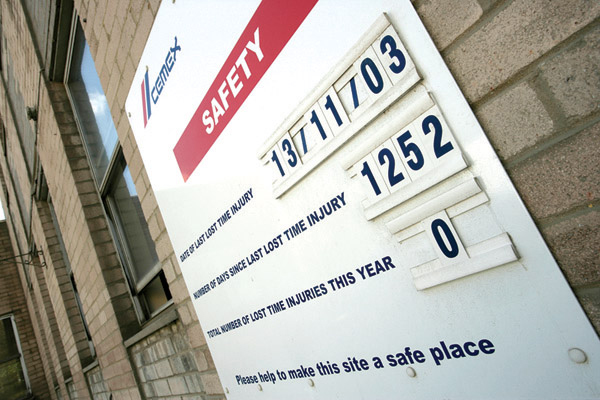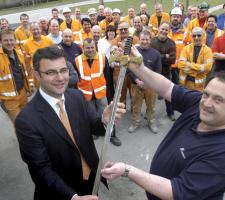
Cemex UK's Barrington quarry and cement plant is a record breaker when it comes to safety. Claire Symes reports
Achieving zero lost time accidents is a target for almost every quarry operator in Europe but reaching this benchmark calls for continual focus and vigilance. One site that appears to have the right ingredients is
In 2007 the site celebrated a new company record, with four years without a lost time injury and was presented with a special award to mark the occasion. The operation was presented with the Cemex safety sword - awarded annually since 1966 - for the best safety performance across the company's businesses in Europe, Middle East, Africa, Asia and Australia.
In fact, the site has only had one lost time injury in the last eight years but, according to plant director Philip Baynes-Clark, the site's safety record is no accident. "The site has had a good history of safety but that can change overnight and there is a real need to continually drive development in order to maintain the record," he said.
The Barrington site has been producing cement since 1927 and the existing 1963 kiln has undergone a number of upgrades to give the site a capacity of 265,000tonnes of clinker and 285,000tonne of cement each year. Around 99% of the materials used in the cement works are provided from the adjacent quarry, which extracts up to 400,000tonnes of chalk and clay each year.
"The plant is not Cemex's largest one in the UK but the kiln is the longest at 136m. Refinements and automation are enabling it to work at 25% above its design capacity at 850tonnes per day," explained Baynes-Clark. "The plant is a wet process facility and we use several alternative fuels to bring the operating costs in line with more modern dry process operations." The cement plant and quarry has a 70-strong workforce, which although is not as large as some cement plants, still requires significant input to ensure training and housekeeping is up to date.
The training and initiatives introduced at Barrington have helped it to earn outside recognition with three consecutive top safety awards from the UK's
Learning process
While the site has a good record, not only has it been achieved through training but also through learning from mistakes made both at Barrington and at other similar sites.
"The last lost time injury at Barrington happened about eight years ago," explained Barrington safety manager Tom Gemmel. "We used to have a train system for bringing material from the quarry into the cement side of the operation and the accident occurred during application of the manual brake. The operative tried to apply the brake stick but it slipped and he was hit in the face and needed to take a day off work to recover.
"After the incident we reviewed the system and decided to remove the railway and move to using articulated dump trucks to transfer material from the quarry to the raw plant. The incident itself highlighted an issue with potential wear and the danger of distraction during the braking process, but there were also other potential issues with the system, such as the difficulty in finding spares, the high voltage cables needed for power and the risk of wagon derailment." According to quarry manager John Drayton, the changeover to using the
Key improvements
While the site has clearly achieved a high level of safety, Baynes-Clark and his team started work on implementing a number of key improvements last year to ensure continued safe operation.
"One of the things we looked at in-depth was housekeeping and maintenance," said Baynes-Clark. "In one part of the site we had a compound where old and broken equipment was stored for spares but with up to 50 years worth of equipment in the area it was difficult to know what was there and to safely access it, so the area was cleared. The housing for the drag chain was also repaired with the missing panels replaced.
"With a focus on reducing the potential for slips, trips and falls, site paths are checked informally on a daily basis but on a formal basis every week. The top of the cement silo was also cleaned and is now done regularly - although it is out of sight, it shouldn't be out of mind." Barrington seems to have placed a real emphasis on taking care of the site and listening to workers' suggestions for improvements in a bid to encourage employees to take responsibility for both the appearance and safety of their environments.
Other initiatives launched encouraged a reduction in manual handling wherever possible and introduction of the 'get a grip' campaign to ensure three points of contact when working at height. The result of this is that gas bottles for the laboratory are now located where the supplier can deliver directly and a fall arrest system is now fitted over the wash mill to prevent operatives swinging and injuring themselves.
The focus on safety also extends to the health of employees. "We have to acknowledge that we have an ageing workforce here with the average age of employees being in their early 50s," said Gemmel. "The risk of heart attacks for this age group is significantly higher so we have invested in automatic heart defibrillators with audible instructions to ensure medical help can be delivered quickly if needed. The equipment will not work if it detects a heart beat so no special training is needed to use it.
"We also encourage operatives to talk to their colleagues about health issues so there is greater awareness of any potential problems." The site uses regular meetings with representatives from each department to ensure any potential health and safety problems are highlighted early and dealt with quickly. To keep track of progress the site has key performance indicators and these are updated weekly.
Next target
If the current working practices at Barrington help to keep its workers safe beyond November this year, the site will reach five years without a lost time accident. But when Baynes-Clark was asked if it is achievable, he said, "There is no room for complacency. Reaching the current record has called for site staff to continually focus on safety and one lapse could mean the count goes back to zero. It would be good to reach the five year figure but we need to take it one day at a time."
















